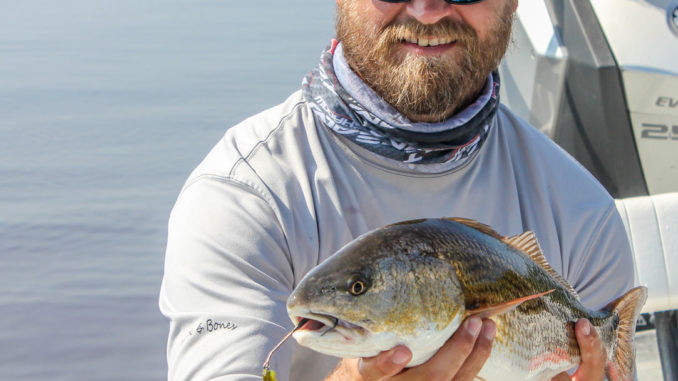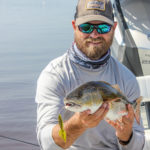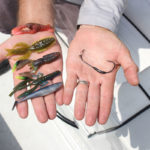
For brackish water redfish in the Carolinas, take a page from the Louisiana playbook and play the crawfish trump card.
If ever there has been a redfish wonderland, few would disagree that it rests in the big toe of boot-shaped Louisiana, where the mighty Mississippi River channels the remainder of its inertia into a vast delta system that floods the wetlands with freshwater, creating a unique blend of low-salinity marshes next to the salty Gulf of Mexico.
Some may argue that redfishing there is a borderline fantasy due to the sheer numbers of fish, and nothing is applicable to anywhere else, but two Carolina anglers beg to differ. They have brought home tactics acquired fishing alongside Louisiana anglers in redfish tournaments and are using them to boat Carolina fish.
One of the largest effects of the high flow of sweet water is the overlapping of freshwater and saltwater habitat and forage. This puts predators like largemouth bass and the redfish — which has no problem with low salinity and brackish water — head to head. In those areas, Cajuns fish for the two side by side with conventional bass lures like spinnerbaits, topwater frogs and spoons.
But it’s in the Carolinas that redfish get a peek at a crustacean not seen in saltwater: the crawfish. While it may seem unique to the bayou, many coastal Carolina river systems contain similar conditions in their upper reaches, but few inshore anglers have experimented with the popular crawfish pattern.
Until now.
Jason Dail of Wilmington and Allen Jernigan of Sneads Ferry are guides and tournament partners on several trails, including the IFA Redfish Tour, and they’re reaping the benefits of crawfish-crazy reds.
“What makes it work is that the fish down there come in from the Gulf, and they’re feeding in those nursery areas in the brackish water, and they’ll move all the way up to the freshwater,” said Dail (910-540-0319), of Silver Spoon Charters. “They’re seeing those crawfish once they get up into that higher estuary freshwater environment. Whether they’re in brackish water, saltwater or freshwater, those fish are accustomed to seeing that type of bait. I think that’s why it works here, too.”
“It works the same way here,” echoed Jernigan (910-467-1482), who runs Breadman Ventures. “A lot of anglers just haven’t picked up on it yet. I like using Deep Creek’s Floating Flip Craw. It’s a little bit heavier than a lot of the traditional craws that the bass fishermen use. You can reach out there and touch them with it. That, and the bait floats, so if you Texas rig it on a light swimbait hook, it’ll fall real slow. I’ll use a ¼- to 1/8-ounce depending on the situation and current. I fish it on 12- to 15-pound Fins Windtamer braid with a 20-pound fluorocarbon leader.”
“I try to imitate the natural tendencies of a crawfish,” Dail said, “keeping it close to the bottom. I make light bounces but keep it within 12 inches of the bottom. I like something that’s heavy enough that it puffs a little mud when it hits the bottom. I give it a sharp twitch when it falls back down, and that gives it the appearance that either a shrimp is popping off or a crawfish is jumping or a mullet is kicking off.
“Deep Creek Lures makes several different varieties, like the Katie Bug Craw, but anything that resembles a crawfish will work. I fish them on a 5/0 to a 7/0, weightless to a ¼-ounce weedless hook, like a swimbait hook. I like the watermelon in the tannic or stained water. Anything that’s clear (or) light brown is best. In darker water, something that’s a little more purple or blue. The darker the water, the darker the bait, just to provide that contrast.”
A key difference between fisheries in Louisiana and the Carolinas is the tidal exchanges. While the Carolinas can look for high and low tides six hours apart, Louisiana tides are closer to 12 hours apart, which means a decreased flow of water, driven more by wind than lunar pull. And understanding the difference has served Dail and Jernigan well on their home waters. Rather than staking out and expecting moving water to bring fish to them or trigger a bite, they go on the hunt. Trolling motor down, they blind-cast to points and pockets in grass lines and the shallow sides of dropoffs while scanning for the tell-tale signs of active fish in the forms of tailing, belly crawling in extremely shallow water, pushing a wake or busting bait. In situations when fish aren’t showing and murky water limits their range for detecting baits, they pull out another Cajun country standard — the popping cork.
“You got some places in Louisiana where the water is just gin clear,” Jernigan said. “You can see the fish 30 to 40 yards away. And then, you’ve got places where the water is like chocolate milk. That popping cork does the trick in that kind of stuff.”
Although Dail and Jernigan will sometimes use soft-plastic crawfish under a cork, they often switch to shrimp or baitfish imitations to mimic the bait that would most likely be under the feeding frenzy simulated by the popping cork.
“I like the Betts’ Perfect Sinker Shrimp or a Salty Bay Minnow under the cork on a 1/8- to ¼-ounce jighead,” Dail said. “I use them beneath a Betts concave, weighted popper. It has a cupped mouth, that makes it chug in the water, instead of just a pop.”
The basic operating procedure for a popping cork is to give the rod a sharp jerk, pulling it forward and creating the pop, or in this case, chug, as the mouth pulls air beneath the water’s surface and resonates through the shallow water. One should pause briefly to allow the bait to fall back in the strike zone and then repeat.






Be the first to comment